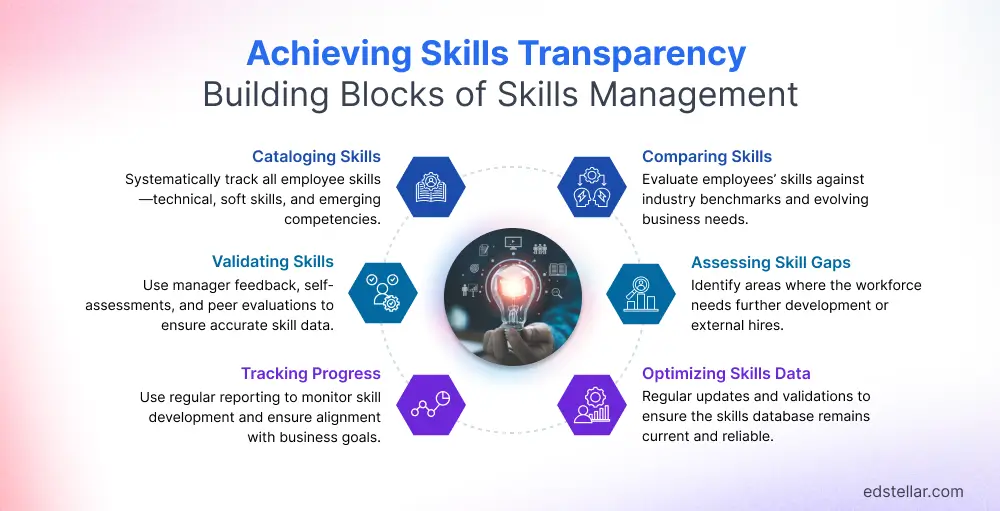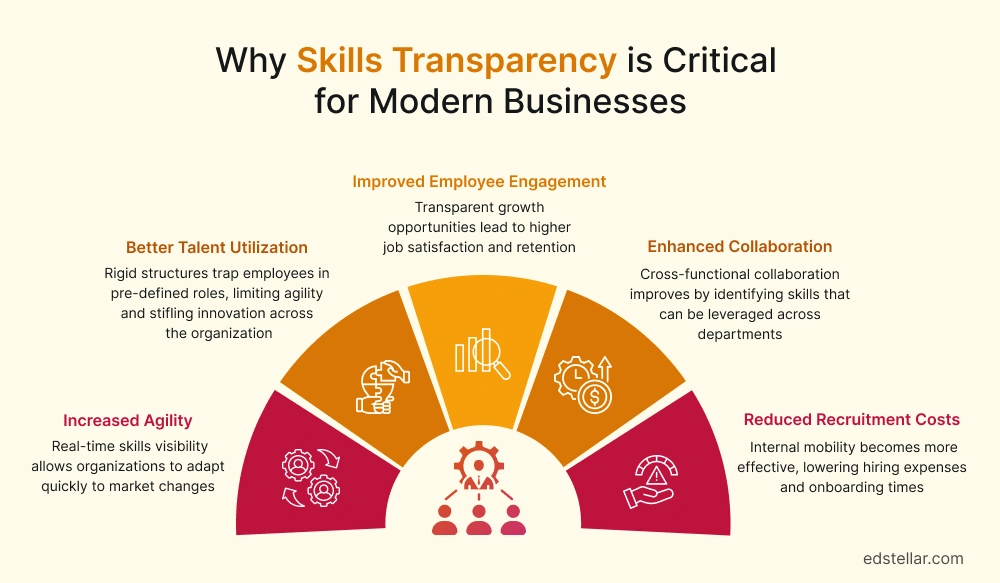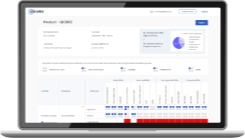
Drawing in from Deloitte's 2023 Global Human Capital Trend,”in a boundaryless world, work isn’t defined by jobs, the workplace isn’t a specific place, and many workers aren’t traditional employees.” As organizations embrace more flexible, project-based structures, leaders face an increasing challenge: understanding the full range of skills within their teams. With roles becoming more fluid, knowing exactly who possesses which expertise at any given moment is crucial for keeping teams aligned and responsive.
When leaders have a clear view of their workforce's strengths and capabilities, they can make quicker, better-informed decisions, ensure smoother collaboration, and remain adaptable to the constantly shifting demands of the business world. Working in this regard, modern enterprises are adopting "boundaryless roles" that prioritize skills and deliverables over fixed titles, according to the Association for Talent Development (ATD).
This shift requires a more dynamic approach to talent management, where understanding and leveraging the diverse skills of the workforce becomes essential for driving innovation and staying ahead of industry trends.
What is Skills Transparency?
Skills transparency refers to a state where organizations gain complete visibility into the full spectrum of skills possessed by their workforce. It’s an evolving system that offers leaders and HR teams the ability to access up-to-date, detailed insights into the skills, expertise, and capabilities of each employee in real time. Rather than relying on static records or assumptions, this transparency provides a dynamic, fluid view that grows and adapts alongside the workforce.

In a skills-transparent organization, employees’ capabilities are continuously tracked and updated, ensuring that teams have the most accurate and comprehensive data available. This access goes beyond a simple list of qualifications; it encompasses the diverse, often hidden, skills that emerge through daily tasks, cross-functional projects, and personal development efforts.
With this holistic view, HR leaders can measure their talent capital accurately, set plans more effectively, and create a robust framework for workforce development that aligns with the organization’s future needs.
By embracing skills transparency, organizations unlock a powerful tool for talent management, fostering an environment where employees are empowered to develop their skills and pursue new growth avenues. This data-driven approach allows businesses to stay agile, adapt quickly to market shifts, and remain competitive in an ever-changing business landscape.
Why Skills Transparency is Critical in Modern Business Environment

- Lack of Agility in Adapting to Change: As organizations face rapid technological changes and market disruptions, they need the ability to quickly pivot talent resources to meet emerging demands. Without visibility into the skills of their workforce, organizations struggle to reassign talent efficiently during such transitions.
- Missed Opportunities for Cross-Functional Collaboration: Many employees possess a broader range of skills than their job titles suggest. However, without transparency into these capabilities, organizations miss opportunities to assemble cross-functional teams that could drive innovation and solve complex challenges.
- Increased Recruitment and Training Costs: Organizations often hire externally for skills they already have internally, simply because they are unaware of the capabilities present within their own workforce. This results in higher recruitment expenses and longer onboarding times.
- Difficulty in Succession Planning and Leadership Development: Without visibility into the skills and potential of employees, it becomes difficult for organizations to identify future leaders or develop a robust succession plan. This lack of foresight can leave companies vulnerable during times of change or leadership transition.
- Talent Underutilization and Engagement Issues: Employees may be underutilized in roles that don’t align with their skills, leading to disengagement, lower productivity, and higher turnover. Lack of skills transparency prevents HR leaders from effectively matching employees to roles that would better leverage their talents.
- Difficulty in Meeting Evolving Business Needs: As business goals and market conditions shift, organizations need to quickly realign their workforce to meet these new demands. Without skills transparency, they lack the insights needed to make quick, informed decisions about reallocating talent or reskilling employees.
What are the Measures Organizations can Take to Achieve Skills Transparency
Achieving skills transparency is a strategic transformation that requires careful planning and consistent action. Below are the key steps organizations can take to operationalize this vision effectively:
1. Conduct a Comprehensive Skills Audit
Begin by systematically mapping the existing skills of your workforce. This audit should capture both formal qualifications and informal, hidden capabilities that employees have developed through experience.
2. Create and Continuously Update a Living Skills Inventory
Once the skills audit is complete, establish a dynamic skills inventory that can be updated regularly. Employees should update their skills after completing new projects, certifications, or training.
3. Integrate Cross-Departmental Feedback
To achieve a more comprehensive skills overview, integrate feedback from managers across various departments. This helps avoid silos and ensures skills are recognized across functions.
4. Identify and Assess Skill Gaps
After building your skills inventory, assess where skills gaps exist by comparing current capabilities with the evolving needs of the business.
5. Link Skills Data to Development Plans
Once gaps are identified, use this data to create personalized development plans for employees, aligning their career goals with the company’s objectives.
6. Encourage Continuous Feedback and Development Conversations
Promote regular conversations between managers and employees about career growth, skills development, and performance feedback. These discussions help ensure that employees are focused on the right skills and feel motivated to continue their growth.
Skills Transparency: The Way Ahead
As market volatility and technological disruptions continue to accelerate, organizations that prioritize skills transparency will gain a decisive competitive edge. According to Deloitte’s 2023 Global Human Capital Trends report, 87% of executives believe that having real-time visibility into workforce skills is critical to navigating future disruptions.
Leaders equipped with comprehensive, real-time insights into workforce capabilities can respond to market shifts with greater agility, capitalize on emerging opportunities, and drive sustained innovation.
Furthermore, skills transparency strengthens employer branding, attracting top talent eager to work in environments where growth and development are valued. A LinkedIn Workplace Learning Report revealed that 94% of employees would stay longer at a company that invests in their career development, underscoring the importance of clear, actionable growth pathways.
In a future where adaptability is the ultimate currency, skills transparency transforms talent from a static asset into a dynamic strategic advantage. For leaders, investing in this transformation is not merely an HR initiative , it is a critical pillar of long-term organizational resilience and success. By proactively adopting skills transparency, organizations position themselves to thrive in an era defined by rapid change and constant reinvention.
Conclusion
For forward-thinking leaders committed to building agile, future-ready organizations, skills transparency is an essential strategic lever. By illuminating hidden talent, aligning capabilities with business priorities, and fostering a culture of trust, leaders unlock unparalleled opportunities for innovation and growth.
At Edstellar, we enable this transformation through our advanced Skills Intelligence platform and specialized L&D consulting services. Our solutions help organizations map, validate, and dynamically manage workforce capabilities, providing the deep visibility required to make data-driven talent decisions and align skills with evolving business strategies.
With Edstellar as your partner, you can accelerate workforce agility, strengthen succession pipelines, and drive continuous development, empowering your organization to stay resilient and competitive in an ever-changing market.
Explore High-impact instructor-led training for your teams.
#On-site #Virtual #GroupTraining #Customized

Bridge the Gap Between Learning & Performance
Turn Your Training Programs Into Revenue Drivers.
Schedule a ConsultationEdstellar Training Catalog
Explore 2000+ industry ready instructor-led training programs.

Coaching that Unlocks Potential
Create dynamic leaders and cohesive teams. Learn more now!


Want to evaluate your team’s skill gaps?
Do a quick Skill gap analysis with Edstellar’s Free Skill Matrix tool

Transform Your L&D Strategy Today
Unlock premium resources, tools, and frameworks designed for HR and learning professionals. Our L&D Hub gives you everything needed to elevate your organization's training approach.
Access L&D Hub Resources.svg)
.svg)



.svg)

.svg)
.svg)
.svg)
.svg)

